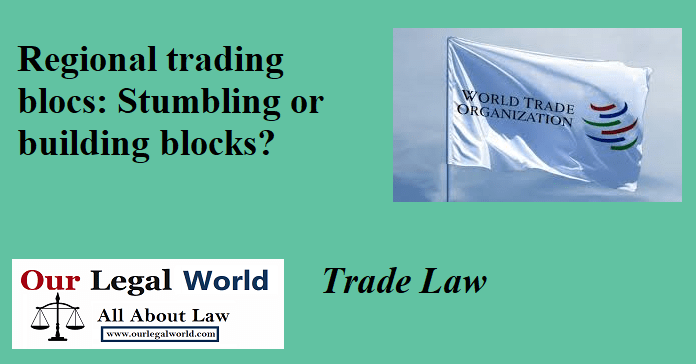Regional trading blocs: Stumbling or building blocks?
INTRODUCTION
Regional trading blocs have been a striking feature of international trade ever since the 1900s. Initially, the growth of regional trading blocs was encouraged by the World Trade Organization (WTO). However, the increase in regional trading blocs is now seen as a major cause of concern for the system of trade under WTO. A trading bloc is a trade agreement between various states aimed at removing trade barriers for member states. The essential features that one must vary of when talking about trade blocs is that trade blocs firstly aim at removing trade difficulties and permit trade efficiency. Secondly, it is discriminatory as it is only applicable to those who are member states and non-member states are not given the same treatment. The very principle for the establishment of trade blocs is in line with the principles of the World Trade Organization. General Agreement on Tariffs and Trade and WTO (the successor of GATT) both follow the principle of non-discrimination. The underlying foundation of this principle states that no discrimination must be made between GATT members. The very objective of GATT and now WTO is that there must be economic openness and trade barriers must be lessened for the benefit of all.
Also Read: REVIEW OF ARTICLE 27.3(B) UNDER TRIPS AGREEMENT: OURLEGALWORLD
However, the second foundation of WTO that lies on the premise of the Most Favoured Nation (MFN) is said to be in clear conflict with the principles of a trading bloc. The Principle of Most Favoured Nation requires equal treatment of foreigners and locals in trade matters. Even though trading blocs promote the reduction of trade barriers, they do tend to impose restrictions on other states that are not part of the trading bloc. WTO rules permit countries to form regional trading blocs and trade amongst themselves. This would help them get easier market access than what applies to the nations that are part of WTO. The unfortunate circumstance, in this case, is that the countries that are not part of the RTAs tend to lose out. The WTO does not consider RTA to be under its purview and off late has commented on the discriminatory nature of RTAs despite it being in line with the multilateral trading system.
LITERARY DEBATE
The number of trading blocs has grown ever since the 1900s. One such example of a trading bloc is the European Union. It is believed that regional trading blocs allow promoting liberalization more efficiently than multilateral agreements. Economists have argued that the transactions are smoother and straightforward as compared to WTO negotiations. The transactions are efficient as smaller groups are parties to the transaction and consensus on matters of sensitive sectors can be reached quickly. This is a stepping stone for the future of liberalization according to few economists.
However, according to other economists even though regional trading blocs are efficient and helpful in the expansion of liberalization, they tend to have a discriminatory feature. RTAs tend to divert trade and low-cost producers not part of the RTA do not seem to benefit from it. Since the main aim of WTO is to foster trade relationships between nations and support sustainable development, this feature of RTA is very contradictory to the principle of WTO.
BUILDING BLOCKS OR STUMBLING BLOCKS?
Many theories support the formation of regional trade blocs as the creation of the same is quite self-enforcing in nature. For any non-member to avail of the service, they have to become a part of the RTA. Economic integration and strengthening of relationships between nations on a one to one level is the key factor. The international trade practice of comparative advantage is more prominent in these types of arrangements. It is seen that regional trade agreements and multilateral trade negotiations are complementary to each other and hence the formation of an RTA helps in liberalization to a large extent.
However, while looking at the quick way of achieving liberalization, one must not overlook the monopoly that is given to just a few units. When a trading bloc is established, the level of trade barriers that are set for other non-members is high. The more members a regional trading bloc has, the higher will the tariff be set at for non-members and more the monopoly power it has. As the world sees a rise in regional trading blocs, it will also see that each group will shift the scales of trade in its favour by raising the tariffs against other blocs. This competition will eventually lead to a decrease in the quality of trade reduction of economic welfare.
Economists like Panagariya and Bhagwati believed in the bandwagon effect of RTAs. Since countries like the European Union and the United States were getting involved in RTAs, many developing countries were prompted to do the same. The bandwagon effect is seen in no country wanting to be left out of a bloc. This effect may cause problems, as unlike custom unions, members of a bloc are allowed to retain their trade tariffs and barriers and the positive impact of that is quite questionable. The lack of participation in a multilateral trade regime by members of a regional trade bloc can harm international trade. Although regionalism is an essential feature of a multilateral system, it cannot be a substitute for the same.
The growing number of trading blocs in the world will cause a potential problem as products in one country will depend on the origin of the same in the home country and reliance will increase. This phenomenon which is known as the “spaghetti bowl” is bound to lead to a problem of transparency in global trade.
CONCLUSION
Economists are conflicted over the actual nature and effects of regional trading blocs. Although years have been spent over this debate, there is yet no consensus. Regionalism is the reality of our global trading system and is bound to have some effects on the WTO regime. It has turned out to be a solution due to the dissatisfaction with the multilateral trading system. However, there are many uncertainties and pitfalls on the path of regionalism which cannot be overlooked. The problems of monopolization are much more acute in a regional trading bloc.
Written by Simran Dalvi [Amity University,Maharashtra(BBA LLB)]








![Tax Law Internship at Legum Attorney [Chamber of Ashish Panday], Delhi : Apply by 15th May 2025](https://www.ourlegalworld.com/wp-content/uploads/2025/05/IMG_0113-min.png)

